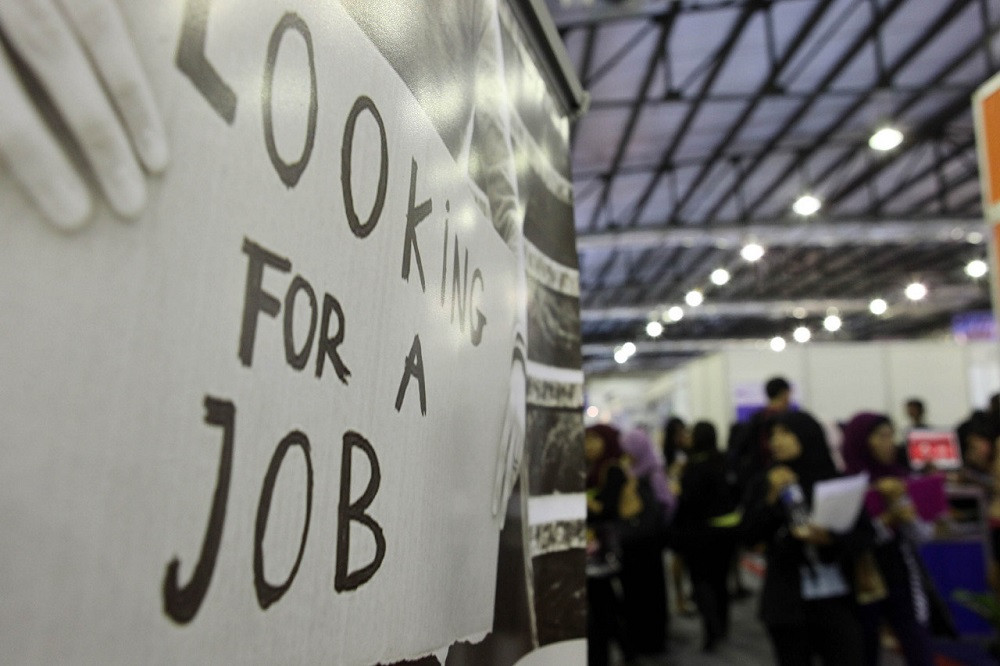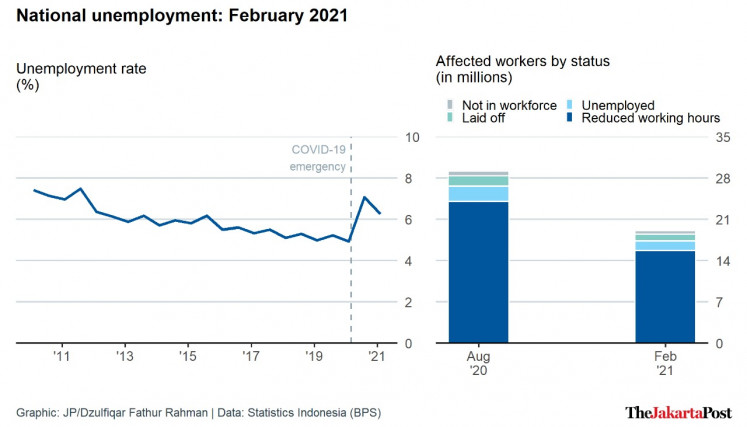RI unemployment still high as millions reel from pandemic ‘fallout’
8.75 million jobless in February: BPS
Change Size

T
he national unemployment rate in February remained at a high 6.26 percent as millions of workers continue to reel from the economic impacts of the COVID-19 pandemic, even after partial resumption of business activities.
Around 8.75 million workers were unemployed in February, increasing by 1.82 million workers from the same month last year, according to Statistics Indonesia (BPS), which released on Wednesday its figures from a biannual survey of 75,000 households conducted in February.
“There has been an improvement, but not a return to the normal level,” BPS head Suhariyanto told a virtual press conference on Wednesday.
February’s unemployment figure is at a level last seen in August 2015.
The economic fallout from the COVID-19 pandemic drove unemployment to a decade-high rate of 7.07 percent in August 2020, when the Indonesian economy began to slide into its first recession in over two decades as mobility restrictions halted business and public activities, leading to lower demand for labor.

The country’s gross domestic product (GDP), which relies heavily on household consumption, contracted 0.74 percent year-on-year (yoy) in the first quarter of 2021 to indicate budding recovery, despite the negative growth figure.
"We cannot yet expect the unemployment rate to return to the February 2020 level, since economic growth remains negative," Adi Rahman, a researcher at the SMERU Research Institute, told The Jakarta Post by text message on Thursday.
Adi, who specializes in poverty, education, labor and development economics, added that businesses, especially micro and small enterprises, were still holding back from hiring new workers due to the prevailing uncertainties of the prolonged health crisis. A declining trend in wages, job security and labor protection also remained a risk because many businesses were still in survival mode.
Nevertheless, with the economy starting to pick up, the number of affected workers had fallen by 10.02 million to 19.1 million from August 2020 to February 2021. The February figure accounted for 9.3 percent of the workforce, with the majority working shorter hours at lower pay.
The number of workers with reduced hours, most of who were urban males, declined by 8.31 million to 15.72 million over the same period.
Furthermore, 940,000 citizens found some form of employment, which lowered the number of unemployed workers to 1.62 million in February, while around 660,000 workers were rehired to lower the number of laid-off workers to 1.11 million.
The public health crisis still pushed around 650,000 Indonesians out of the workforce, but the February figure was still 110,000 workers less compared to last August.
“Some were still pushed out of the workforce. They used to work but no longer work now, and have not been looking for a job ever since they became out of the labor force,” said Suhariyanto of BPS.
The share of informal workers in February stood at 59.62 percent, up by 2.98 percentage points (ppt) compared to a year earlier, with the decline in formal employees offset by an increase in unpaid family workers.
The share of manufacturing workers shrank by 0.44 ppt to 13.6 percent in February. In contrast, the share of workers in agriculture and trade, the highest contributing industries to workforce absorption, respectively grew by 0.36 ppt and 0.62 ppt.
Separately, data and information services company IHS Markit also found that Indonesian manufacturers had yet to hire more workers despite increasing factory activity, leaving employment levels unchanged while the manufacturing backlog grew for a second consecutive month.
Read also: Indonesia posts record manufacturing PMI for 2nd month in row
In a press release on May 3, IHS Markit economics director Andrew Harker expressed a hope that manufacturers will “feel confident enough to start expanding workforce numbers in the months ahead”.








